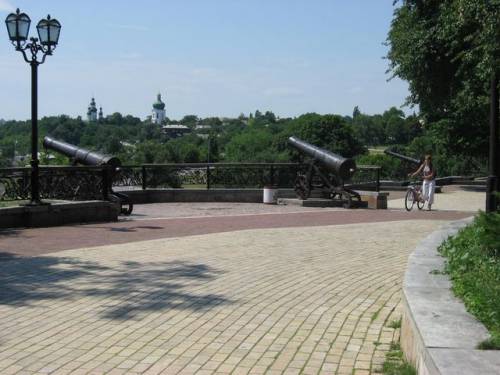 Dytynets’ (Citadel) or Kremlin was inner, mostly reinforced part of ancient cities of Kyiv Rus’
Dytynets’ (Citadel) or Kremlin was inner, mostly reinforced part of ancient cities of Kyiv Rus’.
The name was most probably originated from the old rus’ expression meaning “being situated in the middle of the city”. It was a political-administrative center, inner city where prince’s court, garrison were situated, where boyars (nobles) and clergymen lived. Therefore Dytynets’ (Citadel) was well fortified: earthwork rampart with wall, moats and so on. The rest of inhabitants: craftsmen, merchants and others lived in a so called outer city.
Ancient Chernihiv Dytynets’ (Citadel) is situated on a headland in the interflow of the Desna and the Stryzhen’ rivers. Situated on the crossroads of main natural directions it occupies predominant position over the neighbouring landscape. Such a disposition of Dytynets’ (Citadel) provided the most favourable conditions for controlling the neighbourhoods and visual contacts with them. That’s why the territory of Dytynets’ (Citadel) was the most convenient place for settlement in ancient times.

Archeological excavations on the territory of Chernihiv Dytynets’ (Citadel) started more than 100 years ago (T.V. Kybal’chych, D.Ya. Samokvasov and others). More than 10 thousand sq. meters have been uncovered since the beginning of the exploration. The excavations opened the remains of 4 temples, a terem (a tower-like building for prince’s family), 2 front gates, dozens of dwellings, manufacturing and household buildings were studied, the remains of fortifications were explored, 7 jewelry treasures were found, a great collection of findings was gathered. In its time of prosperity – the first half of the 13th century, total length of Dytynets’ (Citadel) fortifications was 1600 meters and the square – 16 ha.
The headland in the mouth of the Stryzhen’ river had been for the first time mentioned at the beginning of our epoch and that was later proved by the findings of Zarubynes’ka ceramics. Findings of Roman coins of those times also prove that.
A new stage of development was in 7th-8th centuries. The settlement situated here was rather big in area. Its southern part was fortified. The rest of the headland was an agricultural area.
The period of Old Rus’ state formation (end of the 9th-10th centuries) is represented at the Dytynets’ (Citadel) by findings of All-Rus’ types (half-dugout dwellings with pise-walled ovens and early-pottery ceramics, weapon, armed force antiquities and so on). In 80-90s of the 10th century Chernihiv Dytynets’ (Citadel) like most of Old Rus’ centers of the Middle Dnipro regions was greatly reconstructed still occupying South-Eastern part of the city (6 ha). Outside the fortification line city building continued displaying the elements of town planning. Pagan pagoda was situated to the north-west of the settlement.
In 1024 Chernihiv became the capital of the principality and a new stage of development began. Mstyslav Volodymyrovych started building the prince yard and Spas’kyi (Our Savior) Cathedral, the fortified area reached 10.5 ha. Around Borys and Hlib Cathedral a bishop’s yard was formed in the 12th century to which an entrance gate led.
The north-eastern part of the headland, after remaining for a long time outside the Dytynets’ (Citadel), entered its borders in the second half of the 12th century when prince yard was moved to the bank of the Stryzhen’. In the 10th-11th cent. a common town housing system had existed there. Beginning from the 70s of the 10th century houses were replaced by temple-sepulcher and cemetery (10th-12th cent.)
In the last third of the 12th century a new prince yard grew on the northern slope, another architectural complex was formed. In 1174 the building of Mykhailivs’ka and in 1186 – Blahovischens’ka (the Annunciation) churches started. At the beginning of the 13th century the entrance to the prince yard was beautified by a stone gateway with a church.
During the recent excavations some economic buildings of the 12th-13th centuries were opened at the territory of the prince yard – a mead brewery and a mill.
A significant part of its majestic historic-cultural heritage was lost in 1239 when Chernihiv was captured by Mongol army led by khan Mengu. After the weeks of battles Mongols rushed into the city, killed many inhabitants, destroyed dwellings and religious buildings.
For a certain time Chernihiv was experiencing a period of decline and loss of former military and economic power it had had being the center of the biggest of Kyiv Rus’ principalities. Soon a strategic location of Chernihiv-Sivers’kyi region attracted attention of neighbouring states. Lithuania, Poland and Moscow state became an active competition of many centuries for Chernihiv region. Chernihiv went through severe trials: Lithuanian expeditions (1278, 1362, 1404), Polish expeditions (1471, 1604, 1610, 1618), Russian troops expeditions (1503, 1633), Crimean Tartars raids 1482, 1483). Each administration, having occupied the city, tried to turn it into their own fortress. Chernihiv fortress consisted of some lines of strong fortifications: earthwork rampart, moats, wooden walls with fighting towers, underground passage which led to the Desna river, gangways. The fortress was well armed including cannons.
At last in the middle of the 18th century home policy factors, particularly national self-consciousness rise, Cossacks appearance etc, let the Chernihivites influence the situation themselves. In 1648, as Liberation war began, Polish administration and garrison were driven off the city. All further attempts of Polish-Lithuanian troops to capture the city were unsuccessful.
On becoming a regimental center the city began reconstruction, monumental building started at the fortress. In the center of the 18th century the territory of former Dytynets’ (Citadel) was densely built up with housing and administrative buildings. Huge temples, a market place and a cemetery were situated there. Laid of bricks house of Colonel Ya. Lyzohub was built in the 90th. Colonel was the hero of Turkey fortress Azov assault in 1696 and financed St. Catherine’s Church construction to honour Cossacks perished in the siege. Besides, a laid of bricks monastery refectory was built near the Borys and Hlib Cathedral in the end of the 18th century over which a two-tier tower with a belfry and Ioann Bohoslov church were erected. That was the beginning of Chernihiv Collegium.
The building is interesting both for its architectural-spatial composition, sculptural décor, planning and the history of construction as it was the first secondary educational establishment in Left-Bank Ukraine.
Collegium appeared owing to the efforts of Kyiv-Mohyla Collegium alumni Chernihiv archbishops L.Baranovych and I.Maksymovych and financial support of hetman I.Mazepa. The establishment where languages and sciences were taught was all-class and multinational. It existed from 1700 to 1786, gave many educated people, famous medical men of the 18th century in particular. In 1786 it was reorganized into a theological college.
Gradually, terrible and violent war times moved away. The need for a fortress disappeared and it was reorganized in 1799. The garrison was disbanded, the fortifications were demolished, the armaments were almost completely carried out. Instead, cannons at the Citadel remained to protect an ancient city, and the memory about glorious and heroic past of our ancestors.
By 1799 the Chernihiv fortress lost its military importance and was abolished. The fortifications were leveled to the ground at the beginning of the XlX-th century, and a boulevard was arranged on their place. Now it is the favourite zone of recreation for the townspeople, who continue to call this place the Val, accordingly to the ancient custom.
The Val carries on its tradition as an administrative and cultural centre of Chernihiv.
A stone house for the governor was erected on its territory at the beginning of the XlX-th century. Later it was turned over to the boy's classical school. Now the building is occupied by the regional historical museum named after Vasily Tarnovsky.
Approximately at the time of the construction of the governor’s house(1804), the Val was reconstructed to house various provincial organizations, near the archbishop's palace, which had been constructed on the Val in 1780. Now that building is the Pegional State Archives.
A two-storeyed posthouse was built at the beginning the XlX-th century (now Ukrinbank). The Assembly House of the Nobles was erected next to it in 1859-1870 but was later razed.
A two-storeyed boarding school for noble young men was erected in 1894, but it has also not survived to the present day.
A girls' school was built near the classical boys' school at the end of the XlX-th century (1899) and the gymnasium's public garden was laid out in front of these buildings.
Alexander Pushkin's bronze bust was erected in the middle of this garden in 1890.
One of the Val peculiarities are twelve cast-iron cannons, which were placed on gun-carriages overlooking the slope of the hill on the site of the former fortifications.
The legend says that four biggest cannons were presented to the city by Czar Peter I in recognition of the bravery of the Chernihiv Cossacks during the war against Sweden invaders. We will make no effort to disprove this legend because the old story embellishes our the history.
Nowadays the Val is the historical, cultural, and spiritual centre of Chernihiv. Besides the Historical Museum and the Art Museum, there are expositions by the National architectural-historical park "Ancient Chernihiv”
Taras Shevchenko's monument is mounted in the middle of the former citadel. He often visited this place when he stayed in Chernihiv.
Two more monuments appeared on the territory of the Val in the XX th century. Both monuments are connected with the history of Chernihiv in the years of the Great Patriotic War.
One of them is erected above the common grave of the liberators of Chernihiv, who died in 1943 freeing the city from fascists.
Another monument is the Partisans' Stone. It is set on the place where before the war there stood the building of the Town Committee of the Communist Party, where the partisan detachments were formed. The partisans caused heavy losses to the Germans during the occupation and helped the Red Army to liberate Chernihiv Region.
The building was burnt by Germans while retreating in 1943.
From the citadel one can see the beautiful panorama of the Desna floodplain and the Boldin Hills with the ancient Rus monasteries Eletsky-Uspensky and Trinity-lllinsky on their peaks.































